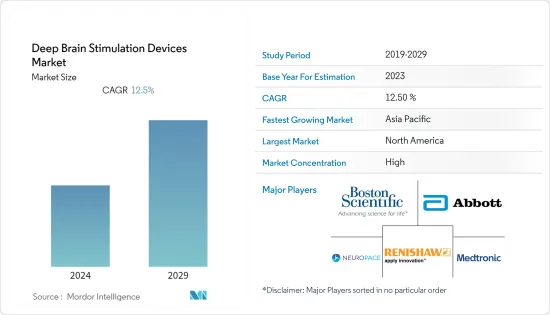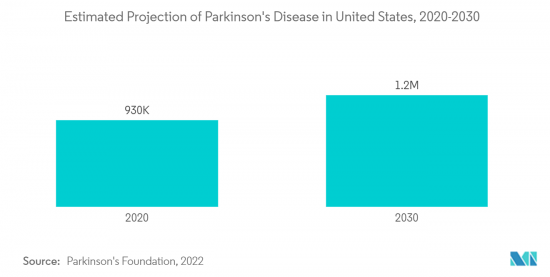 |
市場調査レポート
商品コード
1404436
脳深部刺激療法装置:市場シェア分析、産業動向と統計、2024~2029年の成長予測Deep Brain Stimulation Devices - Market Share Analysis, Industry Trends & Statistics, Growth Forecasts 2024 - 2029 |
||||||
● お客様のご希望に応じて、既存データの加工や未掲載情報(例:国別セグメント)の追加などの対応が可能です。 詳細はお問い合わせください。
| 脳深部刺激療法装置:市場シェア分析、産業動向と統計、2024~2029年の成長予測 |
|
出版日: 2024年01月04日
発行: Mordor Intelligence
ページ情報: 英文 112 Pages
納期: 2~3営業日
|
- 全表示
- 概要
- 目次
脳深部刺激療法装置市場は予測期間中に12.5%近いCAGRで推移する見込み。

COVID-19パンデミックは市場成長に大きな影響を与えると予想されます。パンデミックの制限により、脳深部刺激療法(脳深部刺激療法)装置で治療を受けている神経疾患を患う患者の運動症状や精神症状が悪化しました。パンデミックは脳障害の負担を悪化させ、脳深部刺激管理に関連する慢性ストレスを急増させました。2021年8月にNeurologia Journal誌が発表した研究によると、パンデミックの間、パーキンソン病患者におけるCOVID-19の有病率は11.28%でした。しかし、脳深部刺激療法(脳深部刺激療法)を受けているパーキンソン病患者のCOVID-19は18.18%でした。このように、COVID-19患者の神経障害の悪化は、著名な参入企業に新しい脳深部刺激療法デバイスの開発を促し、市場の成長に大きな影響を与えました。例えば、2022年10月にNature Journalが発表した論文によると、パンデミックは欧州地域に存在するハンガリーのような国々で脳深部刺激療法遠隔プログラミングの採用を加速させました。
さらに、有力企業はパンデミックの間、脳深部刺激療法治療を必要とする患者を積極的に支援しました。例えば、2021年3月、アボット社はNeuroSphere Virtual Clinicを立ち上げ、患者が医師とつながり、脳深部刺激療法装置の適切な設定と機能を遠隔で保護できるようにしました。米国FDAが承認したNeuroSphereバーチャルクリニックは、COVID-19のロックダウンのために医療クリニックに行くことができなかった慢性運動障害に苦しむ患者の最適な治療への患者アクセスを強化しました。したがって、全体的なシナリオを見ると、COVID-19の大流行によって神経疾患に苦しむ患者の状況は悪化しました。しかし、遠隔ソリューションの採用が増加したため、市場は安定した成長を記録し、予測期間中に大きな成長が見込まれます。
脳深部刺激療法は、進行したパーキンソン病(PD)、本態性振戦、ジストニアの治療法として広く用いられています。ここ数年、その臨床応用の拡大に加え、脳深部刺激技術も著しい成長を遂げています。市場開拓の主要要因としては、神経疾患のリスクと有病率の高さにつながっている急速な高齢化、低侵襲手技の人気の高まりによる装置需要の増加、技術的に高度な脳深部刺激療法装置の入手可能性などが挙げられます。
てんかんのような様々な神経疾患の有病率の上昇は、予測期間中の市場成長を促進すると予測されています。例えば、WHOが2023年2月に発表した主要事実によると、世界中で約5,000万人がてんかんを患っており、世界的に最も一般的な神経疾患の1つとなっています。同資料によると、てんかん患者の約80%は中低所得国に居住しています。さらに、市場参入企業は世界各国で先進的な脳深部刺激療法装置の発売を積極的に行っており、これも市場成長を急成長させています。例えば、2022年8月、Medtronic plcの子会社であるMedtronic Private Limitedは、インドで運動障害とてんかんを治療するための脳深部刺激療法治療用指向性リードシステムSenSightを発売しました。同様に2022年12月、Medtronic plcは振戦とパーキンソン病患者を治療する脳深部刺激療法システム、パーセプトPCを韓国で発売しました。パーセプトPCにはブレインセンス技術が搭載されており、神経症患者に電気的脳深部刺激療法治療を提供します。
したがって、上記の要因により、予測期間中に市場は大きく成長すると予想されます。しかし、脳深部刺激手技に伴うリスクや厳しい政府政策の実施が、予測期間中の市場成長の妨げになると予想されます。
脳深部刺激療法装置の市場動向
パーキンソン病分野が予測期間中に大きな市場シェアを占める見込み
パーキンソン病の世界の有病率の増加により、効果的な治療オプションに対する需要が高まっています。脳深部刺激療法は、パーキンソン病の症状を管理し、患者の生活の質を改善するための貴重な治療法として浮上しています。例えば、NIHが2023年1月に発表した論文によると、パーキンソン病(PD)はアルツハイマー病に次いで2番目に多い神経変性疾患であり、主に50歳以上で発症します。しかし、PD患者の5~10%は50歳以前に診断され、毎年約50万人のアメリカ人がPDと診断されています。したがって、PDの有病率の高さは、治療のための高度な脳深部刺激療法技術に対する需要を促進し、それによって市場の成長を促進すると予測されます。また、カナダ政府が2022年4月に発表した記事によると、カナダでは現在、40歳以上の9万人以上がPDを患っています。より正確なターゲティングやプログラミング機能など、脳深部刺激療法技術の進歩が治療の有効性と安全性を高めています。
また、パーキンソン病に対する脳深部刺激療法の利点について、患者や医療専門家の間で認識が高まっていることも、市場の成長に寄与しています。さらに、継続的な研究開発活動、製品の上市、脳深部刺激療法技術向上のための提携、適応症の拡大が市場を前進させています。例えば、2022年8月、Aster Medcity HospitalとMedtronic plcは、インドでパーキンソン病患者のための包括的かつ先進的な脳深部刺激療法プログラムを構築するために提携しました。このプログラムは、外科医がより正確な脳深部刺激療法治療の決定を下せるようにすることで、PD管理を改善することを目的としています。
したがって、上記の要因により、パーキンソン病分野は予測期間中に大きく成長する可能性が高いです。

北米が市場で大きなシェアを占め、予測期間中も同様と予想される
脳深部刺激療法装置市場の地域別分析では、北米が世界市場で大きなシェアを占めています。これは、同地域におけるさまざまな神経疾患の有病率の上昇、著名な参入企業の存在、製品発売数の増加によるものです。例えば、CDCが2022年5月に更新したデータによると、米国では現在約300万人の成人がてんかんを患っています。また、米国精神医学会が2022年10月に更新したデータによると、強迫性障害(OCD)は米国で年間約2~3%の人が罹患しています。そのため、この地域ではさまざまな神経疾患の有病率が高く、高度な脳深部刺激療法装置に対する需要が高まり、地域市場の成長が促進されると予測されています。さらに、同地域にはさまざまな有力企業が存在し、先進脳深部刺激療法装置の発売に積極的に参加していることも、同地域の市場成長を後押ししています。例えば、2022年7月、Abbottは米国で治療抵抗性うつ病に脳深部刺激療法システムを使用することで、米国FDAからブレークスルーデバイス指定を受けました。また、2022年4月、Boston Scientific Corporationは、STIMVIEW XTを搭載した最新の画像誘導プログラミングソフトウェアVercise Neural Navigatorの米国FDA承認を取得しました。この脳深部刺激療法装置は、PDや本態性振戦の患者の脳解剖学的構造のリード配置と刺激モデリングの両方を可視化します。
したがって、この地域市場は、上記の要因によって予測期間中に大きな成長を遂げると予想されます。
脳深部刺激療法装置産業概要
脳深部刺激療法装置市場は、少数の主要市場参入企業の存在により、統合されています。市場参入企業には、Abbott Laboratories、Beijing Pinchi Medical Equipment、Boston Scientific Corporation、Fisher Wallace、Functional Neuromodulation Ltd.、Medtronic PLC、NeuroPace Inc.、Renishaw PLCなどがあります。
その他の特典:
- エクセル形式の市場予測(ME)シート
- 3ヶ月間のアナリスト・サポート
目次
第1章 イントロダクション
- 調査の前提条件と市場定義
- 調査範囲
第2章 調査手法
第3章 エグゼクティブサマリー
第4章 市場力学
- 市場概要
- 市場促進要因
- 神経疾患のリスクと高い有病率につながる人口の急速な高齢化
- 低侵襲手技の普及に伴う装置需要の増加
- 技術的に高度な脳深部刺激療法装置の入手可能性
- 市場抑制要因
- 脳深部刺激療法に伴うリスク
- 市場に悪影響を及ぼす政府政策の実施
- ポーターのファイブフォース分析
- 供給企業の交渉力
- 買い手/消費者の交渉力
- 新規参入業者の脅威
- 代替品の脅威
- 競争企業間の敵対関係の強さ
第5章 市場セグメンテーション(市場規模-米ドル)
- 製品タイプ別
- シングルチャンネル脳深部刺激療法装置
- デュアルチャンネル脳深部刺激療法装置
- 用途別
- パーキンソン病
- 本態性振戦
- 強迫性障害
- てんかん
- ジストニア
- その他の用途
- エンドユーザー別
- 病院
- 外来手術センター
- その他のエンドユーザー
- 地域別
- 北米
- 米国
- カナダ
- メキシコ
- 欧州
- ドイツ
- 英国
- フランス
- イタリア
- スペイン
- その他の欧州
- アジア太平洋
- 中国
- 日本
- インド
- オーストラリア
- 韓国
- その他のアジア太平洋
- 中東・アフリカ
- GCC諸国
- 南アフリカ
- その他の中東とアフリカ
- 南米
- ブラジル
- アルゼンチン
- その他の南米
- 北米
第6章 競合情勢
- 企業プロファイル
- Abbott Laboratories
- Beijing Pinchi Medical Equipment Co., Ltd.
- Boston Scientific Corporation
- Fisher Wallace Laboratories
- Functional Neuromodulation Ltd.
- Medtronic
- NeuroPace Inc.
- Renishaw PLC
- Aleva Neurotherapeutics S.A.
- LivaNova PLC
第7章 市場機会と今後の動向

The deep brain stimulation (DBS) devices market is expected to register a CAGR of nearly 12.5% during the forecast period.
The COVID-19 pandemic is expected to have a significant impact on market growth. The pandemic restrictions worsened motor and psychiatric symptoms in patients suffering from neurological disorders treated with deep brain stimulation (DBS) devices. The pandemic worsened the burden of brain disorders and surged the chronic stress related to deep brain stimulation management. According to the study published by the Neurologia Journal in August 2021, during the pandemic, the prevalence of COVID-19 in Parkinson's patients was 11.28%. However, COVID-19 in Parkinson's patients undergoing Deep Brain Stimulation (DBS) was 18.18%. Thus, the worsening of neurological disorders amongst COVID-19 patients encouraged the prominent players to develop novel DBS devices, significantly impacting the market growth. For instance, according to the article published by the Nature Journal in October 2022, the pandemic accelerated the adoption of DBS teleprogramming in countries like Hungary, present in the European region.
Furthermore, the prominent players actively assisted patients requiring DBS treatment during the pandemic. For instance, in March 2021, Abbott launched the NeuroSphere Virtual Clinic, allowing patients to connect with physicians and remotely safeguard DBS devices' proper settings and functionality. The US-FDA-approved NeuroSphere Virtual Clinic enhanced patient access to optimal treatment for patients suffering from chronic movement disorders who could not go to the healthcare clinic because of COVID-19 lockdowns. Therefore, looking at the overall scenario, the COVID-19 pandemic worsened the situation of patients suffering from neurological disorders. However, the market registered stable growth due to the increased adoption of remote solutions and is expected to witness significant growth during the forecast period.
DBS is a widely used treatment for advanced Parkinson's disease (PD), essential tremors, and dystonia. Over the past few years, in addition to the extension of its clinical applications, there has been tremendous growth in deep brain stimulation technology. The major factors driving the development of the market include the rapidly aging population, which is leading to risk and high prevalence of neurological disorders, growing demand for the devices due to the rising popularity of minimally invasive procedures, and availability of technologically advanced deep brain stimulation devices.
The rising prevalence of various neurological disorders like Epilepsy is projected to drive the market growth during the forecast period. For instance, according to the key facts published by the WHO in February 2023, approximately 50 million people worldwide have Epilepsy, making it one of the most common neurological diseases globally. As per the same source, about 80% of people with Epilepsy live in low- and middle-income countries. Furthermore, the prominent players are actively participating in the launch of advanced DBS devices in various countries worldwide, which is also burgeoning the market growth. For instance, in August 2022, Medtronic Private Limited, a subsidiary of Medtronic plc, launched the SenSight directional lead system for DBS therapy to treat movement disorders and Epilepsy in India. Similarly, in December 2022, Medtronic plc launched its DBS system, Percept PC, in South Korea to treat tremors and Parkinson's patients. Percept PC is equipped with BrainSense technology to provide electrical DBS treatment to neurological patients.
Therefore, the market is expected to grow significantly during the forecast period due to the abovementioned factors. However, risks associated with deep brain stimulation procedures and the implementation of stringent government policies are expected to hamper market growth during the forecast period.
Deep Brain Stimulation Devices Market Trends
Parkinson's disease segment is expected to hold a significant market share during the forecast period
The increasing prevalence of Parkinson's disease globally has created a higher demand for effective treatment options. DBS has emerged as a valuable therapy for managing Parkinson's symptoms and improving patients' quality of life. For instance, according to the article published by the NIH in January 2023, Parkinson's disease (PD), after Alzheimer's disease, is the second-most common neurodegenerative disorder, mainly in people aged 50 years or older. However, 5 to 10 per cent of people with PD are diagnosed before age 50, and around 500,000 Americans are diagnosed with PD yearly. Therefore, the high prevalence of PD is projected to drive the demand for advanced DBS technologies for treatment, thereby driving market growth. In addition, according to an article published by the Government of Canada in April 2022, more than 90,000 individuals aged 40 and older are currently suffering from PD in Canada. The advancements in DBS technology, such as more precise targeting and programming capabilities, have enhanced the efficacy and safety of the treatment.
Additionally, growing awareness among patients and healthcare professionals about the benefits of DBS for Parkinson's disease has contributed to market growth. Furthermore, ongoing research and development activities, product launches, partnerships to improve DBS technologies, and expanding indications have propelled the market forward. For instance, in August 2022, Aster Medcity Hospital and Medtronic plc partnered to build a comprehensive and advanced DBS program for Parkinson's patients in India. The program aims to improve PD management by allowing surgeons to make more accurate DBS therapy treatment decisions.
Hence, due to the abovementioned factors, the Parkinson's Disease segment will likely grow significantly during the forecast period.

North America is expected to hold a significant share in the market and is expected to do the same during the forecast period
The geographical analysis of the deep brain stimulation devices market shows that North America holds a significant market share in the global market. This is due to the rising prevalence of various neurological disorders in the region, the presence of prominent players, and the increasing number of product launches. For instance, as per the data updated by the CDC in May 2022, approximately 3 million adults in the United States are currently having Epilepsy. In addition, as per the data updated by the American Psychiatric Association in October 2022, Obsessive Compulsive Disorder (OCD) affects around 2-3% of people in the United States annually. Therefore, the region's high prevalence of various neurological disorders is projected to create a high demand for advanced DBS devices, augmenting regional market growth. In addition, the presence of different prominent players in the region and their active participation in launching advanced DBS devices is also driving the regional market growth. For instance, in July 2022, Abbott received breakthrough device designation from the US FDA for using its DBS system in treatment-resistant depression in the United States. In addition, in April 2022, Boston Scientific Corporation received the US FDA approval for its latest image-guided programming software, Vercise Neural Navigator, with STIMVIEW XT. The DBS device visualizes both lead placement and stimulation modeling of the brain anatomy of patients living with PD or essential tremors.
Thus, the regional market is expected to witness significant growth during the forecast period due to the abovementioned factors.
Deep Brain Stimulation Devices Industry Overview
The deep brain stimulation devices market is consolidated, owing to the presence of a few major market players. Some market players are Abbott Laboratories, Beijing Pinchi Medical Equipment Co., Ltd., Boston Scientific Corporation, Fisher Wallace, Functional Neuromodulation Ltd., Medtronic PLC, NeuroPace Inc., and Renishaw PLC.
Additional Benefits:
- The market estimate (ME) sheet in Excel format
- 3 months of analyst support
TABLE OF CONTENTS
1 INTRODUCTION
- 1.1 Study Assumptions and Market Definition
- 1.2 Scope of the Study
2 RESEARCH METHODOLOGY
3 EXECUTIVE SUMMARY
4 MARKET DYNAMICS
- 4.1 Market Overview
- 4.2 Market Drivers
- 4.2.1 Rapidly Aging Population, Leading to Risk and High Prevalence of Neurological Disorders
- 4.2.2 Growing Demand for the Devices, Due to Rising Popularity of Minimally Invasive Procedures
- 4.2.3 Availability of Technologically Advanced Deep Brain Stimulation Devices
- 4.3 Market Restraints
- 4.3.1 Risks Associated with Deep Brain Stimulation Procedures
- 4.3.2 Implementation of Government Policies Negatively Affecting the Market
- 4.4 Porter's Five Forces Analysis
- 4.4.1 Bargaining Power of Suppliers
- 4.4.2 Bargaining Power of Buyers/Consumers
- 4.4.3 Threat of New Entrants
- 4.4.4 Threat of Substitute Products
- 4.4.5 Intensity of Competitive Rivalry
5 MARKET SEGMENTATION (Market Size by Value-USD)
- 5.1 By Product Type
- 5.1.1 Single-channel Deep Brain Stimulator
- 5.1.2 Dual-channel Deep Brain Stimulator
- 5.2 By Application
- 5.2.1 Parkinson's Disease
- 5.2.2 Essential Tremor
- 5.2.3 Obsessive Compulsive Disorder
- 5.2.4 Epilepsy
- 5.2.5 Dystonia
- 5.2.6 Other Applications
- 5.3 By End User
- 5.3.1 Hospitals
- 5.3.2 Ambulatory Surgical Centers
- 5.3.3 Other End Users
- 5.4 Geography
- 5.4.1 North America
- 5.4.1.1 United States
- 5.4.1.2 Canada
- 5.4.1.3 Mexico
- 5.4.2 Europe
- 5.4.2.1 Germany
- 5.4.2.2 United Kingdom
- 5.4.2.3 France
- 5.4.2.4 Italy
- 5.4.2.5 Spain
- 5.4.2.6 Rest of Europe
- 5.4.3 Asia-Pacific
- 5.4.3.1 China
- 5.4.3.2 Japan
- 5.4.3.3 India
- 5.4.3.4 Australia
- 5.4.3.5 South Korea
- 5.4.3.6 Rest of Asia-Pacific
- 5.4.4 Middle East and Africa
- 5.4.4.1 GCC
- 5.4.4.2 South Africa
- 5.4.4.3 Rest of Middle East and Africa
- 5.4.5 South America
- 5.4.5.1 Brazil
- 5.4.5.2 Argentina
- 5.4.5.3 Rest of South America
- 5.4.1 North America
6 COMPETITIVE LANDSCAPE
- 6.1 Company Profiles
- 6.1.1 Abbott Laboratories
- 6.1.2 Beijing Pinchi Medical Equipment Co., Ltd.
- 6.1.3 Boston Scientific Corporation
- 6.1.4 Fisher Wallace Laboratories
- 6.1.5 Functional Neuromodulation Ltd.
- 6.1.6 Medtronic
- 6.1.7 NeuroPace Inc.
- 6.1.8 Renishaw PLC
- 6.1.9 Aleva Neurotherapeutics S.A.
- 6.1.10 LivaNova PLC
